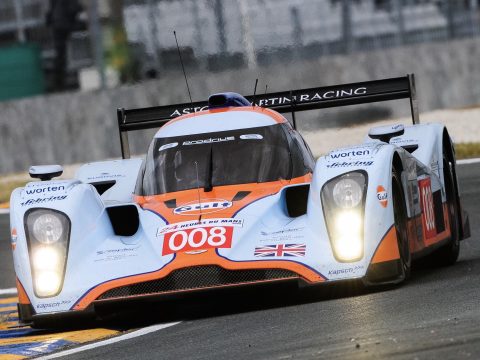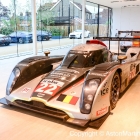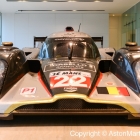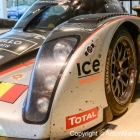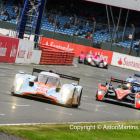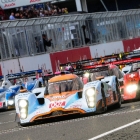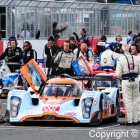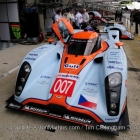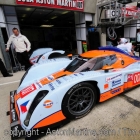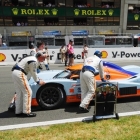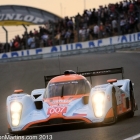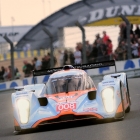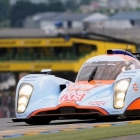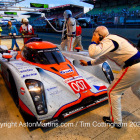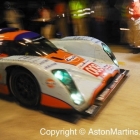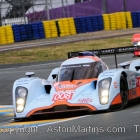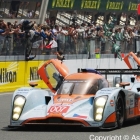The Le Mans prototypes are purpose built race cars and have little in common with road cars at all. Most are open cars with spyder coachwork although closed coupes are also allowed; all have token luggage space and at least the provision of a small passenger seat. They are at least as powerful as GT1 cars, often more so, have a lower minimum weight limit, larger brakes, wider wheels and more aerodynamic downforce. From 2006, diesel powered cars had begun to dominate the LMP1 class due to favorable regulations with the cars from both Audi and Peugeot are the ones to beat.
In 2008, the ACO regulations for Le Mans changed to allow for the use of a GT1 engine within a prototype chassis. Thus Aston Martin Racing took advantage of rule change and provided engines for the Charouz Racing Systems LMP1 entry at that years Le Mans 24 Hours and in the Le Mans Series (LMS) races. Since the V12 is based on a production car engine and is a little heavier, taller and longer than custom-built prototype racing engines, larger air restrictors were allowed which gave a useful increase in power of 50 bhp over that produced when fitted to the DBR9.
Following initial success in 2008 with the Lola B60/08 and Aston Martin V12, AMR made the decision to move fully into the top flight LMP1 class and challenge for an overall win at Le Mans. The car to do this was the Lola-Aston Martin B09/60 (Aston Martin LMP1 for short), an evolution of the previous B08/60 and known internally as the DBR1-2. It was still built by Lola and co-developed by AMR/Prodrive and also involved the parts suppliers Michelin, Koni and BBS. AMR continued to receive sponsorship from Gulf Oil and the car carried the famous blue and orange livery. As in the 2008 car, the Lola-Aston Martin used the same V12 from the DBR9 GT1 car, but the standard Lola gearbox was replaced by a more compact Xtrac 6-speed with paddle-shift. An unusual feature to the car was the rearward brake cooling, which fed air to the brakes through two fans, and eliminates brake ducts on the body. The styling of the Aston Martin LMP1 was not only the product of the wind tunnel but Director of Design, Marek Reichman gave the car the look of an Aston. Two B09/60s (007 and 009) competed in the full LMS season in including the 24 hour race where they were joined by a third car, 008 entered under the AMR Eastern Europe banner for Charouz Racing Systems. The number 007 car won the Le Mans Series overall, and the number 009 finished fourth. At Le Mans, 008 of Jan Charouz, Tomáš Enge and Stefan Mücke finished fourth behind the factory entries of Peugeot and Audi, as well as being the highest finishing petrol-fuelled car.
In 2010, AMR competed at the 2010 12 Hours of Sebring the first appearance of the LMP1 car in the US finishing the race in 3rd position, 3 laps behind the 2 winning Peugeots. Three cars were again entered in the 2010 24 Hours of Le Mans, 007 and 009 by AMR and 008 by the French team Signature-Plus. Both the 008 and 009 cars suffered from problems retired, leaving only the 007 to finish 6th overall after 365 laps, less than it did in 2009. It was the third highest petrol finisher.
Above is DBR1/2-3, a 2010 car and the only example that was only run by private teams, Signature Plus and Kronos Racing. With seven race outings including twice in the Le Mans 24 hours race, the car finished six races. Perhaps the most outstanding result being 7th overall at Le Mans in 2011 in the hands of the Belgian drivers Vanina Ickx, Maxime Martin and Bas Leinders. Here it is displayed in the Aston Martin Works showroom in 2013, still carrying the dirt of it’s final race.
Just to cause some confusion, the DBR1-2 has two chassis numbers. The AMR number is DBR1-2/* whereas the Lola tub has a different number B09/60-* or B10/60-*. As if to cause more confusion, many of the cars have used two different Lola tubs but retained their AMR chassis number. If we only consider the AMR chassis numbering system, there were a total of four cars built, although these four have utilised quite a few more numbered tubs.



